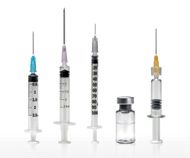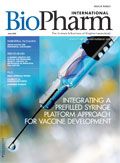Using Plastic for Parenteral Containers
A Q&A with SCHOTT Pharmaceutical Systems and West Pharmaceutical Services

Photo Credit: Maria Toutoudaki/Getty ImagesPlastic is a relatively new material for parenteral containers. BioPharm International spoke with Graham Reynolds, vice-president of marketing and innovation of Pharmaceutical Delivery Systems at West Pharmaceutical Services and Gary Waller, North American vice-president of sales and marketing for SCHOTT Pharmaceutical Systems, to gain insight on the drivers for and concerns with use of plastic in vials and syringes.
TRENDS IN PARENTERAL CONTAINERS
BioPharm: Do you see a trend toward using plastic instead of glass in parenteral containers, such as syringes and vials?
Reynolds (West): There has been a trend toward the use of plastic for primary containment for pharmaceuticals and biopharmaceuticals for many years. The primary market change has been in Japan, where estimates suggest that 60–70% of all prefilled syringes in the Japanese market are plastic, rather than glass. The trend has been driven by increasing demand for higher quality products that will reduce breakage and increase functionality.
Issues with glass breakage and delamination are also causing concern in the marketplace. Glass can break at any time: in production, when used within a device such as an auto-injector, or even when in use by the patient or caregiver. Breakage in production or in the final product may cause loss of sterility of the drug product and hazards to patients and caregivers. With the increasing use of devices as part of a combination product, a glass container may not be visible, resulting in concerns about breakage when a device is dropped and a tendency to err on the side of caution. For example, patient instructions may suggest an auto-injector should be discarded if dropped, due to the risk of glass breakage.
Although Japan has led the way in adopting plastic as a primary container, there has been increased interest from Europe and the United States in use of plastic instead of glass. Recent surveys have placed interest in plastic at different levels, but it is West's understanding that the majority of pharmaceutical and biopharmaceutical companies are at least considering plastic as an alternative to glass.
Waller (SCHOTT): In fact, both materials have advantages as well as disadvantages. Polymer or plastic resists breakage extremely well and is also inert and resistant to broad range of polar solvents, acids, and bases. Polymer can also be used to produce flexible designs and dimensions that are often more difficult to manufacture with glass. Japan has historically been using polymer syringes, due to safety and breakage issues. But it's not really a global phenomenon.
PLASTIC VS. GLASS
BioPharm: What are the main drivers for using plastic instead of glass?
Reynolds (West): The drivers behind the use of plastic vials and syringes instead of glass are very different. In the case of glass vials, the interest in plastic has been led by breakage concerns as well as various product recalls relating to glass particles. Under certain conditions, glass particles (i.e., lamella) are formed by delamination on the surface of the glass vial. In the past several years, FDA has initiated a number of recalls due to the risk that glass particulate may enter a patient through drug products, particularly those that are administered intravenously. A study conducted by West indicated that clinicians have concerns about the potential harmful effects of glass particles when injected into the body, especially directly into the bloodstream. Plastic vials offer an alternative because the nature of the material eliminates delamination and reduces the potential for breakage.
For prefillable syringes, the main drivers toward plastic have centered not only on glass breakage but also on the functionality of the syringes, which must be siliconized when made of glass. It has been shown that when used in conjunction with certain biologic products, particularly proteins, silicone oil can cause problems such as the formation of protein/silicone aggregates, which may alter the integrity of the drug product. Another issue is that in the formation of a glass syringe, a tungsten pin is used to create a hole. The needle is then bonded to the syringe using an adhesive. Residual tungsten has been shown to cause stability problems with certain biologics. Use of plastic syringes provides an alternative that eliminates the needs for silicone oil, tungsten, and adhesives.
In addition, prefillable syringe systems are often used in conjunction with a device, such as a self-injection system or needle-safety system. The inherent variability in the dimensions of glass can lead to challenges when designing a device because many devices put stress on glass products, particularly in the flange area, where breakage can occur.
There are many drugs that, by their very nature, simply do not work as intended when contained in glass. For those applications—whether it is delamination or interaction with particularly aggressive materials—plastic may be the only option.
In addition, one of the many benefits of plastic is that it offers significant design flexibility and increased dimensional precision. When developing more sophisticated devices such as pump systems and patch injectors, the use of a plastic container may offer significant advantages by providing a consistent functionality for the system. For example, an electronic patch injector platform technology (SmartDose, West) uses a polymeric (Crystal Zenith, Daikyo) cartridge that is designed to offer a high degree of dimensional tolerance and functional consistency, which enables the device to function effectively. As another example, a 1 mL-long plastic (Crystal Zenith, Daikyo) syringe has the potential to be filled with a volume in excess of 1 mL and maintain an effective seal.
Waller (SCHOTT): Plastic is used to produce various types of parenteral containers. We continue to experience an increase in discussion around syringes. In other areas such as cartridges, vials, and ampoules, plastic use is a niche. The general advantages of plastic are naturally drivers for using this type of container material. We do not, however, see a trend to switch from established glass containers to plastic containers due to one specific advantage. We have the ability to evaluate the complete package and consider all influencing variables. If glass delamination is a concern, specialized analytical services (SCHOTT Pharma Services) can determine a suitable solution, possibly by using delamination-resistant, coated vials (Type I plus, SCHOTT).
Many pharma companies are looking at the syringe side when speaking about plastic containers. Polymeric, prefillable syringes (TopPac, SCHOTT) are transparent like glass and offered with an integrated luer lock, which makes this system even more robust than a glass syringe, in which the luer lock adapter is attached as a separate component. This solution is ideal for highly viscous drugs, such as hyluronic acid. Flexible design and tight dimensional tolerances make these syringes compatible with various intravenous connectors, thus ensuring patient safety.
CONCERNS WITH PLASTIC
BioPharm: What are the primary concerns with using plastic?
Waller (SCHOTT): Concerns are scratch sensitivity, inferior barrier against oxygen and water vapor, and limited long-term experience. A polymer could be scratch-sensitive if it is not handled more delicately than glass. It is important to keep in mind that scratches are not only a cosmetic defect but can also impair camera inspection. Furthermore, polymers do have challenges in the area of barrier protection against oxygen and water-vapor permeation, and this could pose a problem for certain drugs. Glass has been around much longer, and leading companies have a wealth of knowledge on how it interacts with certain medications. So it really boils down to understanding and selecting the material that suits a specific application most effectively.
Reynolds (West): Glass is a traditional packaging material in the pharmaceutical industry. It has been used for many years, and any novel material presents a potentially risky change in a market that is extremely risk-adverse. However, there are more than 20 products that have been approved and are currently on the market in systems using cyclic olefin polymer (Daikyo Crystal Zenith, developed by Daikyo Seiko and sold by West and Daikyo Seiko). Many other products are available in a variety of plastic materials from other manufacturers. Plastic is not a new material for drug packaging, but for many applications, such as biologics, there is still a concern about the number of products that are approved in plastic.
In addition, there are features of plastic that are different than glass. As an example, oxygen permeability of polymers is typically inferior to glass, and manufacturers must evaluate packaging options on a drug-by-drug basis to ensure that if a product is oxygen-sensitive, proper care is used to select appropriate packaging systems.
In all cases, it is important to understand the needs of the integrated drug-delivery system and evaluate appropriate solutions. When working with a company on high-value or sophisticated biologic products, we may recommend a polymer as an alternative to be evaluated alongside glass. Given what we know about the limitations of glass, it is important to evaluate alternatives based on the drug product, including in what format it will be used (e.g., vial or syringe and whether the primary container will be used within a device). We would make a recommendation to our customers based on the most appropriate packaging solution for their product.

INTERPHEX 2025: Critical Role of Walk-In Chambers in Bio/Pharma Development and Manufacturing
April 3rd 2025Christopher Murphy, director of Global Business Development and Service Customer Support at Environmental Specialties, sat down with the PharmTech Group at INTERPHEX 2025 to discuss the design and critical role of walk-in chambers in the bio/pharmaceutical industry.
AES Clean Technology Launches Next-Generation OSM Utility Solution for Cleanrooms at INTERPHEX 2025
April 2nd 2025Officially launched at INTERPHEX 2025, the Omni ASCENT is a next-generation off-site manufactured vertical utility solution that offers optimized cleanroom flexibility and efficiency.